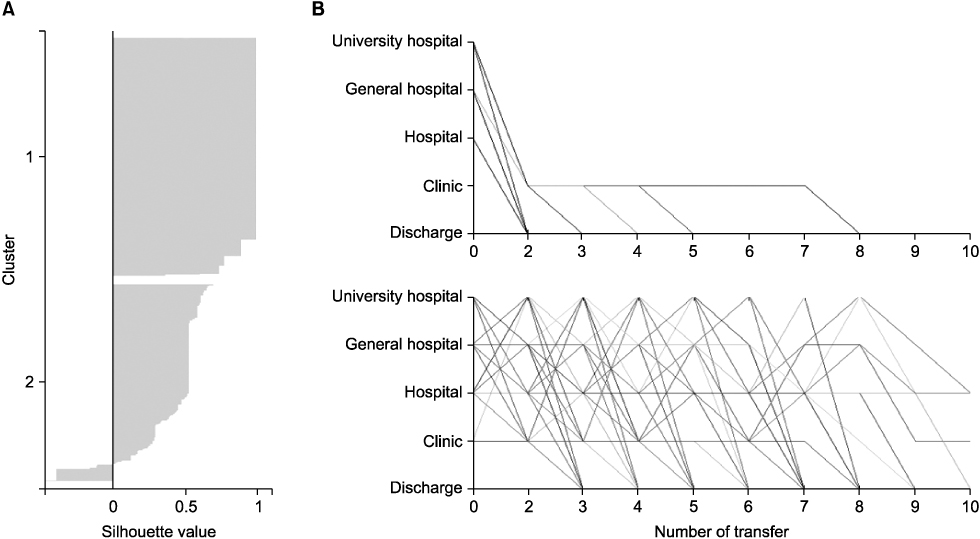Brain Neurorehabil.
2011 Sep;4(2):132-136. 10.12786/bn.2011.4.2.132.
K-means Cluster Analysis on Care Status of Injured Workers with Stroke According to Discharge Disposition Patterns
- Affiliations
-
- 1Department of Rehabilitation Medicine, Seoul National University College of Medicine, Korea. tairyoon@snu.ac.kr
- KMID: 2048468
- DOI: http://doi.org/10.12786/bn.2011.4.2.132
Abstract
OBJECTIVE
This study aimed to characterize the use of medical service and medical costs of each cluster categorized by its discharge disposition pattern. METHOD: Data extracted from Electronic Data Interchange database of Korea Workers' Compensation and Welfare Service was analyzed. Among those who suffered from industrial accidents from Jan 1, 2006 to Dec 31, 2006, 422 were stroke patients. We categorized the subjects into 2 groups using k-means cluster analysis according to the discharge disposition pattern. Demographic characteristics, days of treatment, medical cost, initially admitted medical institution and disease type were analyzed in each group.
RESULTS
There was no difference between the 2 groups in age, sex, type of stroke (ischemic or hemorrhagic stroke) and initially admitted medical institution. However medical cost and days of treatment were significantly different between 2 groups.
CONCLUSION
K-means cluster analysis according to transferring pattern revealed a distinct group with longer hospitalization and more medical cost in injured workers. Further study is necessary to find out the characteristics of this group.
Keyword
MeSH Terms
Figure
Reference
-
1. Jorgensen HS, Nakayama H, Raaschou HO, Vive-Larsen J, Stoier M, Olsen TS. Outcome and time course of recovery in stroke. Part ii: Time course of recovery. The copenhagen stroke study. Arch Phys Med Rehabil. 1995. 76:406–412.2. Hendricks HT, van Limbeek J, Geurts AC, Zwarts MJ. Motor recovery after stroke: A systematic review of the literature. Arch Phys Med Rehabil. 2002. 83:1629–1637.3. Kim YH, Han TR, Jung HY, Chun MH, Lee J, Kim DY, Paik NJ, Park SW, Kim MW, Pyun SB, Yoo WK, Shin YI, Kim IS, Han SJ, Kim DY, Ohn SH, Chang WH, Lee KH, Kwon SU, Yoon BW. Clinical practice guideline for stroke rehabilitation in korea. Brain Neurorehabil. 2009. 2:1–38.4. Cho SC, Choi KH, Lee DJ, Ha SB. Interval between initial hospital arrival and start of rehabilitation therapy in stroke patients of tertiary medical center. J Korean Acad Rehabil Med. 1998. 22:9–14.5. Han TR. The current status of brain neurorehabilitation in korea. Brain Neurorehabil. 2008. 1:1–5.6. Cho WH, Kim HJ, Lee SH. A study on the criteria for selection of medical care facilities. Korean J Prev Med. 1992. 25:53–63.7. Youn K, Doh S. An analysis of the diseases specific medical service organization selection factors of patients. Korean Journal of Hospital Management. 2007. 12:1–21.8. Lee KJ, Moon YH, Cha BS. A comparative study of the hospital charges of long-term and short-term inpatients in the industrial accident compensation insurance system. Korean J Occup Environ Med. 1990. 2:1–12.9. Spath H. The cluster dissection and analysis theory fortran programs examples. 1985. New York: Halsted Press;226.10. Park S. A study on the rehabilitation of long-term patients in industrial accidents hospital. Jangaeingoyong. 2003. 13:5–20.11. Lee KJ, Moon YH, Cha BS. A comparative study of the hospital charges of long-term and short-term inpatients in the industrial accident compensation insurance system. Korean J Occup Environ Med. 1990. 2:1–12.12. Chang H, Yoon SS, Kwon YD. Determinants of inpatient charges of acute stroke patients in two academic hospitals: Comparison of intracerebral hemorrhage and cerebral infarction. J Korean Neurol Assoc. 2009. 27:215–222.13. You HS, Kim JT. Study on the factors for selection of pneumoconiosis care facilities by pneumoconiosis patients [dissertation]. 2007. Chung Nam: Konybuk College.
- Full Text Links
- Actions
-
Cited
- CITED
-
- Close
- Share
- Similar articles
-
- Factors Affecting the Satisfaction of the Hospital Services among Injured Workers
- Analysis of Functional Independence Status and Home Care Needs among Stroke Patients
- A Study on the Industrial Accident of Steel Workers
- The Relationship of MMSE to Functional Improvement in Brain Injured Patients
- Analyzing decline in quality of life by examining employment status changes of occupationally injured workers post medical care


